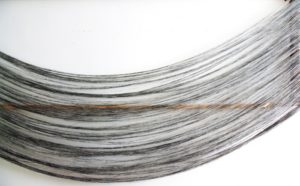Ko Kirk Yamahira has put a lot of work into his upcoming exhibition of paintings in Victoria. He’s bringing 15 pieces to town, all specifically made for the exhibit. The Seattle-based painter says he’s been spending 10 hours a day at work in his Capitol Hill studio to get ready for the show.
“I don’t go out that much,” says Yamahira. “Actually, well, I don’t go out. Most of the time I’m here, I think it’s something I have to do almost, like, daily.”
Yamahira—a self-taught artist and a founding member of New York-based Japanese art collective Art Beasties—began his practice creating silkscreen prints. His prints involved an extensive use of layering, with each piece accumulating up to 10 or 15 separate layers. Over time, his attention shifted away from the surface of the canvas to the canvas itself.
“I realized what I’m using at bottom is the canvas, and I started to focus more about the canvas, more about the possibility of what I’m using for many years,” he says. “And then I think I started to unweave the actual canvas.”
Yamahira unweaves his canvases with fingers, scissors, and an X-Acto knife; the carefully separated threads hang in delicate loops between unmolested sections of canvas. Yamahira’s works blur the line between 2D and 3D; like Lucio Fontana, a painter who began, in 1949, to inflict carefully executed holes and slashes in his canvases, Yamahira is on the verge of sculpture. The work is often described as minimalist.
“Some people say that,” he says. “I mean, I understand that people need to categorize with some names, like ‘minimal art’ or ‘fibre art.’ If that makes it easier [‘minimalist’] might be the name… I try not to title each single painting. It’s all untitled, actually.”
Yamahira tends to undermine the integrity of the stretcher bars as well, leaving, in some cases, entirely deconstructed canvases. An untitled 2018 piece resembles a large skein of pink wool hanging from the wall. The destruction of the canvas is a fundamental necessity in the creation of these paintings.
“I’ve still not completed the possibility of the canvas,” he says, “but I’m kind of interested in the frames too, the wood frame, which is always at the back of the painting and no one sees that—only the artist, maybe, when they’re stretching canvas.”
Bringing together the past and present, Yamahira eventually reincorporated his silkscreening techniques into this new style of painting, with the result being that when someone looks into the unwoven threads it’s still possible to see images. Many of his canvases are pre-treated with acrylics, graphite, and silkscreens.
“It’s kind of like a starting over or a spiral, so I’m not turning to the zero but I’m kind of going around and getting at the starting point above the beginning,” he says.
Yamahira spends an enormous amount of time making his art. While he’s working, he listens to the radio and he thinks—a lot. He describes the process of unweaving as being much more than just a part of his life. It’s not a separate activity like eating a meal or practicing meditation; the unweaving is actually his life.
“When you meditate, I think, you’re going to decide when to start meditating, right? You’re going to start sitting or walking around or be relaxed or you’re going to change your clothes, so you have to prepare something, but what I do, painting is closer to my life,” he says. “My hands are always moving, unweaving canvases, just repeating the same thing over and over and over.”
Ko Kirk Yamahira
Friday, March 8 to Saturday, April 6
(Opening 7 pm Friday, March 8 with a performance at 8 pm)
Deluge Contemporary Art
deluge.ca

